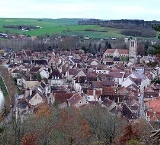
Noyers, Yonne
Encyclopedia
Noyers is a commune
in the Yonne
department in Burgundy in north-central France
.
There are half-timbered houses, ashlars, pillars and pinnacles. There are a lot of lanes and small squares made of chalky and granitic pavements. There are towers surrounded by the river Serein
loops.
Gaul tribe, just before the Roman conquest, or by a contemporary of Julius Caesar called Lucidorius. He would have given the city its first name, Lucida.
Around and after the 12th century the city became the seat of the Miles family. At the end of the twelfth century, Hugues de Noyers, bishop of Auxerre
, built "one of the most famous castles of France". It was beleaguered by Blanche de Castille’s troops in 1217, but it did resist.
In 1419, at the end of the Miles dynasty, Noyers became the property of the dukes of Burgundy. The prince of Condé became count of Noyers. He made a Huguenot place of the city and took refuge in it after the defeat of Amboise conspiracy in 1568. But Catherine de Médicis dislodged him and the garrison surrendered.
Later the castle was dismantled by King Henry IV
in 1599. After a long time of lethargy the city revived in 1710 when the duke of Luynes married the last descendant of the Condé
family.
Wine and grain trade were prosperous at Noyers. A lot of documents attest there were plenty of vines, walnut-trees and cherry-trees over the hills all around Noyers. Till the beginning of the twentieth century a great part of local craftsmen was represented by cartwrights, harness-makers, coopers, farriers and shoe makers. In 1861 there were 128 vine-growers and 25 tillage-farmers. Today they are not so many but farmers are still keeping their places.
Communes of France
The commune is the lowest level of administrative division in the French Republic. French communes are roughly equivalent to incorporated municipalities or villages in the United States or Gemeinden in Germany...
in the Yonne
Yonne
Yonne is a French department named after the Yonne River. It is one of the four constituent departments of Burgundy in eastern France and its prefecture is Auxerre. Its official number is 89....
department in Burgundy in north-central France
France
The French Republic , The French Republic , The French Republic , (commonly known as France , is a unitary semi-presidential republic in Western Europe with several overseas territories and islands located on other continents and in the Indian, Pacific, and Atlantic oceans. Metropolitan France...
.
There are half-timbered houses, ashlars, pillars and pinnacles. There are a lot of lanes and small squares made of chalky and granitic pavements. There are towers surrounded by the river Serein
Serein
The Serein is a river of eastern France. It is the main waterway of the Chablis wine district in Burgundy.-Origin of the name:Serein is the French word for "serene". This may reflect the placid nature of its course, or the strong monastic tradition in the area.-Geography:The Serein rises in the...
loops.
History
The origins of Noyers are unclear. It was founded by the king of SequaniSequani
Sequani, in ancient geography, were a Gallic people who occupied the upper river basin of the Arar , the valley of the Doubs and the Jura Mountains, their territory corresponding to Franche-Comté and part of Burgundy.-Etymology:...
Gaul tribe, just before the Roman conquest, or by a contemporary of Julius Caesar called Lucidorius. He would have given the city its first name, Lucida.
Around and after the 12th century the city became the seat of the Miles family. At the end of the twelfth century, Hugues de Noyers, bishop of Auxerre
Auxerre
Auxerre is a commune in the Bourgogne region in north-central France, between Paris and Dijon. It is the capital of the Yonne department.Auxerre's population today is about 45,000...
, built "one of the most famous castles of France". It was beleaguered by Blanche de Castille’s troops in 1217, but it did resist.
In 1419, at the end of the Miles dynasty, Noyers became the property of the dukes of Burgundy. The prince of Condé became count of Noyers. He made a Huguenot place of the city and took refuge in it after the defeat of Amboise conspiracy in 1568. But Catherine de Médicis dislodged him and the garrison surrendered.
Later the castle was dismantled by King Henry IV
Henry IV of France
Henry IV , Henri-Quatre, was King of France from 1589 to 1610 and King of Navarre from 1572 to 1610. He was the first monarch of the Bourbon branch of the Capetian dynasty in France....
in 1599. After a long time of lethargy the city revived in 1710 when the duke of Luynes married the last descendant of the Condé
Condé
-Places in France:*Condé, Indre, in the Indre département*Condé-en-Brie, in the Aisne département*Condé-Folie, in the Somme département*Condé-lès-Autry, in the Ardennes département*Condé-lès-Herpy, in the Ardennes département...
family.
Wine and grain trade were prosperous at Noyers. A lot of documents attest there were plenty of vines, walnut-trees and cherry-trees over the hills all around Noyers. Till the beginning of the twentieth century a great part of local craftsmen was represented by cartwrights, harness-makers, coopers, farriers and shoe makers. In 1861 there were 128 vine-growers and 25 tillage-farmers. Today they are not so many but farmers are still keeping their places.

